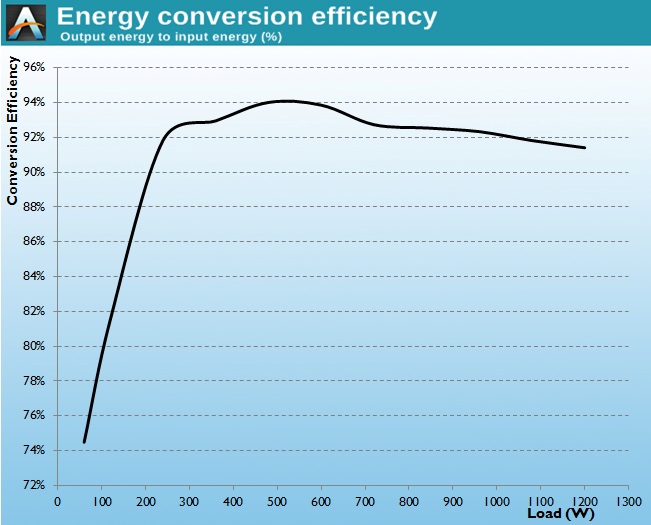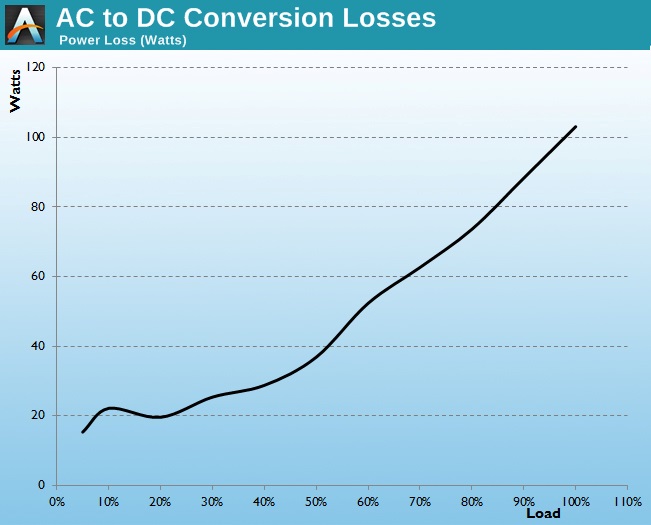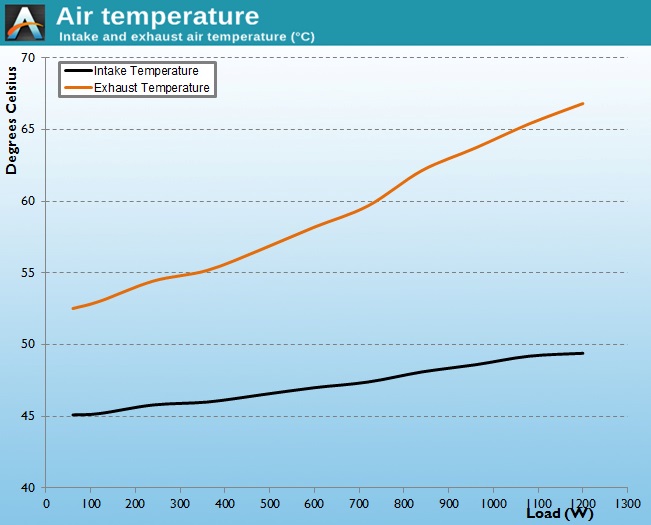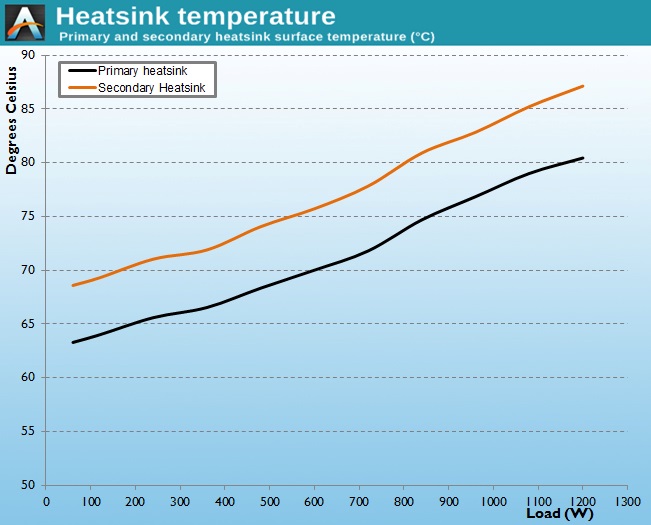The Andyson Platinum R 1200W PSU Review
by E. Fylladitakis on April 24, 2015 8:00 AM EST- Posted in
- Cases/Cooling/PSUs
- 1200W
- 80Plus Platinum
- Andyson
Hot Test Results
As the following tables indicate, Andyson really outdid themselves. The Platinum R 1200W displays exceptional power quality, especially considering the very high power output of the PSU. The maximum voltage ripple on the 12V line is just 26mV at maximum load, under a massive >92A current. The voltage regulation is equally amazing, with a change of less than 0.6% for every voltage line across the load range.
| Main Output | ||||||||
| Load (Watts) | 241.65 W | 603.17 W | 903 W | 1201.18 W | ||||
| Load (Percent) | 20.14% | 50.26% | 75.25% | 100.1% | ||||
| Line | Amperes | Volts | Amperes | Volts | Amperes | Volts | Amperes | Volts |
| 3.3 V | 1.87 | 3.37 | 4.68 | 3.37 | 7.01 | 3.35 | 9.35 | 3.35 |
| 5 V | 1.87 | 5.09 | 4.68 | 5.09 | 7.01 | 5.08 | 9.35 | 5.08 |
| 12 V | 18.71 | 12.07 | 46.77 | 12.05 | 70.15 | 12.03 | 93.53 | 12 |
| Line | Regulation (20% to 100% load) |
Voltage Ripple (mV) | |||||
| 20% Load |
50% Load |
75% Load |
100% Load |
CL1 12V |
CL2 3.3V + 5V |
||
| 3.3V | 0.4% | 4 | 4 | 10 | 16 | 6 | 10 |
| 5V | 0.2% | 4 | 6 | 12 | 16 | 6 | 10 |
| 12V | 0.6% | 6 | 10 | 18 | 26 | 20 | 12 |
We should mention that this PSU does not have a clear temperature rating. This most likely means that it has been rated at 40°C, as this is the commercial computer PSU temperature standard. However, in order to match the 50°C rating of several high-end products, we perform our testing at temperatures higher than 45°C. We could reduce the ambient temperature of our hotbox testing but we chose not to do so as the results would then not be comparable to those of our previous reviews.
According to the following results, it does not seem that Andyson would have any trouble giving this PSU a clear power output rating at 50°C. High ambient temperatures have very little to no effect on the performance of the Platinum R 1200W, which lost a mere 0.15% of its average energy conversion efficiency. In fact, it maintains the 80Plus Platinum efficiency levels, with the maximum efficiency being 94.1% at 40% load.
Despite the great rise of the ambient temperature, the internal temperatures of the PSU do not rise disproportionally. On the contrary, the rise is almost additive, with the internal temperatures of the PSU rising about as much as the ambient temperature did. The fan displays the same behavior, with the only difference being that its speed starts increasing much sooner, yet reaching the same maximum noise levels nonetheless.















46 Comments
View All Comments
ImSpartacus - Saturday, April 25, 2015 - link
I agree.I couldn't care less about giant PSUs.
I want to see reviews of ~500W PSUs because that's the kind of PSU that I would buy.
E.Fyll - Monday, April 27, 2015 - link
You see, the problem is that good <550 Watts PSUs are very rare. In the order of $50, you will get something that works OK and that's about it. Will it really matter if the ripple is 90mV instead of 75mV, or if the average efficiency is 95% instead of 95.3%?Besides,manufacturers do not easily supply samples of such products. I've already discussed the reasons why not many times over. The few good low power units that exist, I am trying to source them. Silver stone sent in a 450 watt unit and we might be getting somewhere with Andyson too.
And no, I cannot just buy the samples. Especially from newegg.
The0ne - Saturday, April 25, 2015 - link
They won't listen lol, it's like they're being paid to do the article...wait a minute, I may be on to something!ImSpartacus - Saturday, April 25, 2015 - link
Yeah, the author says it up front:"When it comes to high performance >1 kW computer power supplies, almost every reputable OEM has released at least one design to serve as their flagship. This is not necessarily because the companies expect high revenue because they are well aware that this segment of the market is very small and overly saturated. They do this because the flagship serves as a symbol of the company's capabilities and competence, enhancing their profile on all fronts in order to produce that halo product, hoping the performance of the high end results in trickle-down sales."
But that doesn't justify it. The bottom line is that I read Anandtech reviews because I want to be educated about potential purchases. However, I'll never purchase a 1000+W PSU. That's just wasteful.
I want relevant reviews and Anandtech needs to demands relevant PSU review units.
JonnyDough - Tuesday, April 28, 2015 - link
Agreed. I own 10 computers, 8 of which are gaming PCs. None have more than a 750w PSU in them, and none will ever need to.computex128 - Wednesday, April 29, 2015 - link
Drop the insanity and buy a dual-GPU card like the rest of us certifiably sane folk :PLoneWolf15 - Friday, April 24, 2015 - link
Andyson didn't just suffer because of Hiper.Remember Ultra power supplies? First modular units made, now house brand of Tiger Direct? Andyson. Many failures, old designs, horrible voltage regulation, never meeting load specs....that's a lot of Andyson PSUs made for the vendors they supply to. While it could be that vendors want Andyson to make cheap units, I wouldn't touch one, even one that rates well. You can do better with other choices.
DanNeely - Friday, April 24, 2015 - link
Thank you for updating your testing methodology to reflect the continued decline in the amount of power available on the legacy (3.3/5v) rails in more modern designs.Laststop311 - Saturday, April 25, 2015 - link
Because legacy systems used lower voltage more. Nowadays everything is 12 volts.CrazyElf - Friday, April 24, 2015 - link
The most important things to consider are:1. Voltage regulation under load
2. Ripple suppression
3. Long term reliability
I would ignore the 80 Plus as it's mostly marketing.
Good power supplies are made by Delta (OEM), Super Flower (their Leadex platform is pretty good), Seasonic, and I would argue some of the Flextronics designs are pretty good too. Brand is mostly for warranty support - it's the OEM that really counts.